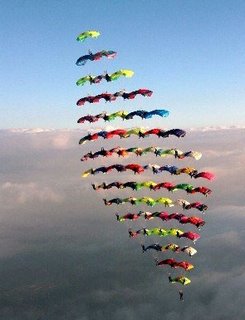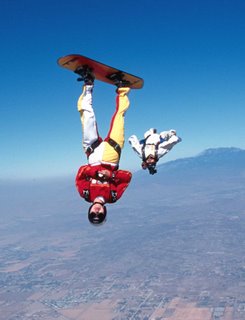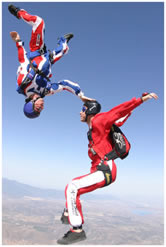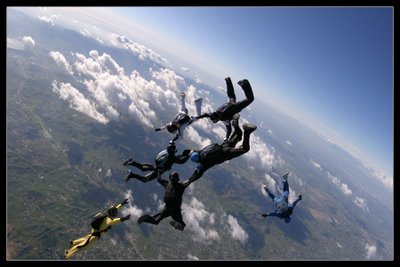Wingsuit Flying

1. Prerequisites for wingsuit flying:
To try a wingsuit you must be a current, licensed skydiver with 500 jumps total OR 200 jumps in the last 18 months. (Note: these rules vary in some countries; please consult your skydiving governing body to be sure)
2. I don't meet the requirements yet / What kind of drills and skydives can I do to prepare myself for my first wingsuit flight?
Tracking dives are excellent training to understand the dynamics of wingsuit flight (high forward speed, reduced descent rate and the need to plan your flight path). Freeflying also helps develop useful air skills.
Perform solo jumps going through the exit, flight path, wave-off and deployment procedures. Experiment with putting your arms and legs into a wingsuit position after exit. (Practice deploying by putting both your hands behind your back and throwing your pilot chute symmetrically as well as doing the wave off with your legs.)
Read the wingsuit manuals available on the manufacturers' websites for more details of wingsuit procedures.
3. I've done 150 jumps in the last 12 months, why do I need to have 200 jumps before I can jump wingsuit?
Like any thing else you take into freefall, be it a sky-board, a camera helmet or a wingsuit, it makes the skydive more complicated and therefore more demanding. The wingsuit restricts your movement and adds complications to your exit, freefall, deployment and ability to deal with some malfunctions.
4. Okay, I meet the requirements what do I do next?
To make your first wingsuit flight it is highly recommended to talk to a wingsuit instructor or an experienced wingsuit pilot. They should also be able to provide you with a demo suit to try.
The instructor / experienced pilot will be able to explain the required procedures to you and make sure you have understood them correctly.
5. There are no wingsuit instructors or experienced wingsuit pilots at my dropzone, what can I do?
It is strongly recommended to consult a wingsuit instructor / experienced wingsuit pilot before jumping a wingsuit regardless of your experience level.
If you have more than 500 jumps you *could* jump a wingsuit on your own after thoroughly preparing yourself by reading all the available information from the wingsuit manufacturer / on the internet and after ample drill practice on the ground.
If you have less than 500 jumps we strongly recommend you try harder to locate a wingsuit instructor / experienced pilot. Contact the manufacturers for assistance.

6. I want to buy a wingsuit, where can I get one?
http://www.bird-man.com
http://www.phoenix-fly.com
http://www.matterclothing.com
http://www.flyyourbody.com
http://www.pressurized.at
http://www.jii-wings.com
The flybirdman.com website also contains a lot of useful information on the different suits available and about wingsuit flying in general: http://www.flybirdman.com
7. There are too many to choose from, how do I know which one I should buy!?
Searching the old posts on the dropzone.com wingsuit forum will usually provide you with user reviews of all the suits. The best option as with any product is to try the suit in person and form your own opinion.
Always check the manufacturers' requirements for each specific suit. There are suits aimed at beginner, beginner/ intermediate and experienced wingsuit pilots.
First timers should always use a beginner suit for their first few jumps. It is common for first timers to rent or borrow a beginner suit before going on to purchase their own suit.
8. What equipment do I need to fly a wingsuit?
In addition to your rig and wingsuit the following are recommended:
-BOC deployment system (no pullout / PUD or bungee collapsible PC)
-A large docile main canopy, especially for your initial jumps
-Helmet
-Goggles
-Wrist mounted altimeter (chest mounted altimeters can give false readings)
-AAD (although the AAD may not work if you fly slower than the minimum activation speed)
-Audible altimeter
-Hook knife, mounted in a location other than your legstrap (legstrap will be difficult to access inside the suit)
Optional equipment:
-Freefall computer to record descent rate (e.g. Neptune, ProTrack etc)
-GPS unit (to record 3D flight path of wingsuit to calculate glide ratio)
If you intend to perform many wingsuit skydives you could consider the following modifications to your skydiving rig:
-Longer bridle
-Dynamic / open corners on your container main tray
-Slightly larger pilot chute
9. I want to do Wingsuit BASE jumping!
Wingsuit BASE jumping is a dangerous activity that has claimed several lives so far. You must be an experienced BASE jumper and experienced wingsuit pilot before attempting to combine the two. For further information check out the Advice for Starting Wingsuit BASE here: http://www.dropzone.com/...tail_page.cgi?ID=506

*info collected from dropzone.com*












